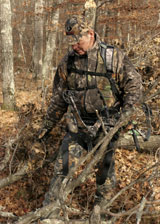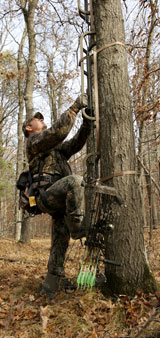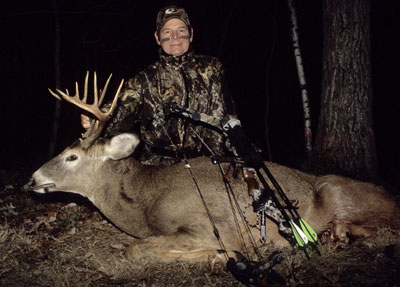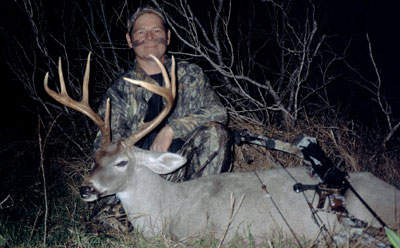October 28, 2010
By Jay Strangis
We're Going Whitetail Hunting, And You Won't Have To Set Your Alarm
By Jay Strangis
We've long been preaching the benefits of hunting whitetail bucks in the morning because mature bucks simply spend more time on their feet in the morning hours of daylight than the evening hours of daylight. So if you want to catch a buck moving, it makes sense to capitalize on his walkabout time, right? Well, maybe.
Although I'd have to agree that mornings are perhaps best, I've always preferred hunting evenings. Maybe it's just my biological clock, but I've had just enough evening success to keep me coming back. As a matter of fact, the last two mature bucks I've taken fell in the evening, each about an hour before nightfall. That may be just coincidence because I hunt mornings just as fervently as evenings, but looking back over the years, I've found some pretty good reasons to key on evening bowhunting for whitetail deer.
Advertisement
HOW WHITETAILS MOVE
Deer biologists point out that whitetail deer get up about every five hours to feed. This puts the average whitetail on its feet about three times during every daylight period. Most of their movements are timed to dawn and dusk, but the moon and weather may alter movements to feed. We've all seen deer on their feet in the middle of the day, and they become more visible where they are undisturbed. Bucks are no exception, though their movements are more secretive in daylight. Some movements to feed, especially during daylight hours, may be little more than rising and feeding in close proximity to their beds.
Advertisement
Bucks put most of their energies into nighttime movements. Some older bucks are strictly nocturnal year round, but most bucks do a good deal of their business on into the morning hours, rubbing trees, scent marking and scraping, and generally putting their mark on their territory. Of course, during the rut, bucks may extend these daylight movements throughout the morning into early afternoon. It's no wonder they are dead tired about the time we are climbing into our stands in the afternoon.
 It's much easier to walk carefully and quietly to a stand site when you can see where you're going. There's also the off chance that you'll get a shot at a deer on the way to your afternoon stand. It happens. |
Armed with this information, it would seem hard to make a case for evening hunting. After all, in the afternoon we are hunting periods of movement that are effectively cut off by darkness. It gets harder and harder to see as the evening wears on and legal shooting time ends, whereas in the morning shooting light only improves. Plus, morning offers the chance to encounter a buck that may be a bit tired and vulnerable yet still on his feet completing what he considers important business.
CONDENSED MOVEMENT
Besides the fact that most of us have jobs that require us to be at work first thing in the morning (yet steal out for a couple of quick hours before dark), there are many good reasons to value an evening hunt. Primarily, I like evening hunting because deer movement is condensed into a shorter burst of prime activity. Especially in areas with normal human activity, deer tend to stay down during the afternoon waiting for things to quiet down. Farm workers, loggers, construction crews, school buses, playing kids and barking dogs all start to knock off in early evening. Remember, deer are better at patterning us than we are at patterning them. The result is a rush of deer movement just before dark. I remember a bowhunt in far northeastern Wisconsin a number of years ago with my friend Tom Perrier. Deer were numbered at about 65 per square mile in that area and when the sun would start to drop it sounded like an army crunching through the fall woods as deer stormed toward the potato fields.
Bucks aren't immune to this activity. They, too, will be shadowing the movements of other deer. On paths from bedding areas to feeding areas bucks are some of the last to move. Hunting stands on these routes can be productive in the evening if you hunt toward the bedding side of things. I've found that the closer you stay to the beds, the higher the odds of encountering a buck before darkness sets in. Expect them to be late. Far from fields, I've been pinned in my stands in the moonlight waiting for bucks to clear my trails after legal shooting time. Bucks move late, it's the nature of their game.
Continued -- click on page link below.
 Climbing trees is a safer activity in daylight hours and it's easier to be stealthy when boarding an afternoon platform. How many times have you heard a deer in the darkness bounding off as you gained your seat? You hope it wasn't the buck you were hunting. |
The upside of all this condensed movement means shorter; more action-packed sits because there are more deer on their feet in the average habitat in the last hour of daylight than there are in the first hour. Let's face it, like those Wisconsin potato eaters; whitetails can't resist the call to get on their feet just prior to dusk, and head for the food.
EASIER TO GET TO A STAND
Morning hunting sucks for several intractable reasons: you must rise with Orion, it's darker than the inside of a whale and it's the coldest time of night or day. But the real bugger about morning hunting is that if you have to go any distance, and you don't have a well-defined trail to follow, it's darn painful getting to that hot stand. Not painful in a hurting way; rather it's painful in a wincing way -- you know, that wince that you get when after a few hundred yards of absolutely flawless footfalls, you crack a large stick and alert everything in creation, especially the deer, that there's something in the woods that doesn't belong. Then there's the "wince" when you're traveling along so well and suddenly an unseen animal is snorting at you and won't stop. This especially happens along field edges, which seem the perfect path to a stand, but happen to be the most dangerous routes of all.
Afternoons are better. First, if you get a good, early start to your stand, deer are generally bedded at this time of day. You can avoid known bedding areas, pick your way slowly and carefully to your stand and mount the structure with few surprises (there's nothing worse than the sound of metal on metal when your roped bow inadvertently strikes a climbing stick or tree stand in the dark).
Once on stand, guess what? It's daylight! Y
ou can glass a bit, study the woods, range a few objects in your shooting lanes, and you may even spot a deer. I've climbed quietly into afternoon stands to find deer bedded within sight. That hasn't happened to me in the morning. If it's a new stand, and the coast is clear, you can practice your draw in a few shooting positions that take advantage of your shooting lanes. That's hard to do in pitch darkness, and dangerous when the light is right for a deer's eyes, but not for yours. I hunted with the guys from PSE once down in Mississippi and one of them used the first hour of an early afternoon to take a practice shot from his stand, just to see where his bow was hitting from that elevation. He drilled a deer from the same stand an hour and a half later.
THE R FACTOR
Afternoons are the warmest time of day, and evenings are generally warmer than mornings; that's the good news, and the bad news. Afternoons can be comfortable for you (you don't have to wear as much clothing, or shiver as much) but mid-season, they're usually uncomfortable for the deer. Deer have grown their winter coats by mid-season in most regions, and a warm afternoon will have them waiting until darkness and cooler temps to move. Afternoon hunting requires cool weather.
Biting cold weather make's afternoon hunts even better. A deer's coat may have an R Factor that keeps it warm, but when the bitter cold comes in northern states, deer are looking for the warmest time of day, rather than the coolest. This is when afternoon hunting takes over. At this time of year, usually December, deer are concentrating on food sources. In daylight, they generally bed during the coldest time of day (morning) and get up to feed during the warmest time of day (afternoon). Hunting these periods was my specialty when I was younger because I knew the bucks would be with the does and that they would be showing up to feed well before dark. I also lived in an area that had a strong mix of agricultural land, primarily corn and soybeans -- crops that are deer magnets when cold sets in.
 This buck was spotted in Jay's hunting area on the morning of the day he shot it. He returned in the afternoon to an existing stand and killed it about a half hour before sunset as it followed a doe. |
Continued -- click on page link below.
 This buck had been spotted using the area near a ground blind and Jay used an afternoon hunt to get lucky. The buck was chased into bow range by a larger buck. |
TACTICS FOR EVENING
Evening hunting can be broken down into a few simple formulas. Primarily, the closer you hunt to bedding areas, the sooner the action will start. Long walks through difficult terrain call for an early departure, allowing time to move carefully and quietly. If your honey hole is back away from it all, it's likely bedding areas lie close by. Better to arrive early and wait for the action to start than to stumble into moving deer on the way to your stand. Calling can be effective in these spots, especially fawn bleats and light rattling. Deer, even mature bucks, are curious, and attracted to both.
As stated earlier, most afternoon activity starts relatively late in the day and is condensed into an hour or so of prime hunting. An exception my friends and I have noticed is during the days around a full moon, when afternoon activity looks more like morning activity. During afternoons of the full moon, deer seem to rise from their daytime beds early and randomly. We often see the first deer hitting open fields at 2 p.m. during these periods, and deer movement is spread throughout the afternoon. Try arriving at your stand an hour or so earlier during the first days of a nearly full, or full moon. If you don't, I believe you'll be spooking moving deer on the way to your stand.
Food is what deer are seeking in their afternoon/evening starts, and as any experienced archery hunter knows, it's generally easy enough to scout straight to the source. Acorn, or other mast stands deep in the forest are relatively easy to set up on, but the more common and obvious crop fields are much more difficult. The problems are many, but primarily the fields hold numbers of deer, so the odds of getting picked off are high. The edges of fields often harbor difficult winds. If you try to hunt deer that are entering the field, a face-on wind will spook deer behind you in the timber. If you try to put the wind at your back, some crazy doe is going to cross your scent stream 100 yards out in the field and set the whole herd on edge or worse.
On a tip from the boys at Double Bull Archery, we've tried ground blinds set right in the open field with some success. Deer study the blind and discount it because it's not hidden and isn't moving. Don't try to hunt the blind in gusting winds because swirling currents will blow scent all over the place. A light, steady flow from the direction you expect the deer to come from is best, and by all means, use every scent control trick you own.
A more obvious solution to the evening food equation involves getting between the deer and their food source somewhere in mid-stream. This takes a lot more scouting and scheming and usually will involve some kind of natural feature that funnels the deer. Beaver ponds, lakes and rivers are naturals, especially if you can find them in close proximity, but cover itself can be an effective funnel. In the prairies, we hunt whitetails along single windrows, especially those that border creeks or deep ditches, any obstacle the deer can't or won't normally cross at will. Finding a crossing along these routes is like striking gold. Any formation along a travel route that encourages deer to turn suddenly leads to a likely funnel, and it may be nothing more than the brush and timber itself that turns them. These kinds of corners will see regular deer movement.
Don't expect your afternoon travel-route stand site to be good from year to year. The best of these stands is only as good as the food source on the other end. Thus, each year you have to evaluate what the deer are doing and where they are headed. Sites that produce generally do so again when the food source returns or repeats itself.
Remember that whitetails are quite dedicated to their home range during most of the year. They'll travel a mile or more for good feed, but they remain quite dedicated to a favorite bedding area. Tracing these routes and evaluating stand potential is the key to evening success. You may get outlasted by a big buck on these late-in-the-day travel routes, but there's always that one animal that due to weather, time of year or who knows what, will make a mistake. Be there when it happens, settled and ready, and you'll be a believer in the magic of the evening.
